Method for generating non-human mammalian chimeric embryo
a technology of chimeric embryo and non-human mammalian, which is applied in the field of generating non-human mammalian chimeric embryo, can solve the problems of thorny problems for many reasearchers, difficult to generate chimeric animals, and laborious follow-up breeding, etc., and achieves the effect of simple and effectiv
- Summary
- Abstract
- Description
- Claims
- Application Information
AI Technical Summary
Benefits of technology
Problems solved by technology
Method used
Image
Examples
example 1
Generating Chimeric Mouse Embryo using the Method of the Present Invention
Source of the Mice, Housing, and Feeding Evnironment
[0054] The mice were obtained from the Laboratory Animal Center, National Taiwan University College of Medicine and the National Laboratory Animal Center. The housing, feeding, superovulation, mating, and surgery were carried out according “A Guidebook for the Care and Use of Laboratory Animals” published by the Chinese Association of Laboratory Animal Science in 2001. The use of mice has been approved by this Institutional Animal Care and Use Committee.
[0055] The mice was raised in a clean conventional rodent animal facility. The air, pressure, lighting, and temperature of each animal room were independently controlled. The positive pressure and fresh air of each room were maintained by HEPA filters and pressure releaser. The light and dark cycle (14L:10D) in the animal room were controlled automatically. Temperature (18-26° C.) and relative humidity con...
PUM
 Login to View More
Login to View More Abstract
Description
Claims
Application Information
 Login to View More
Login to View More - R&D
- Intellectual Property
- Life Sciences
- Materials
- Tech Scout
- Unparalleled Data Quality
- Higher Quality Content
- 60% Fewer Hallucinations
Browse by: Latest US Patents, China's latest patents, Technical Efficacy Thesaurus, Application Domain, Technology Topic, Popular Technical Reports.
© 2025 PatSnap. All rights reserved.Legal|Privacy policy|Modern Slavery Act Transparency Statement|Sitemap|About US| Contact US: help@patsnap.com



